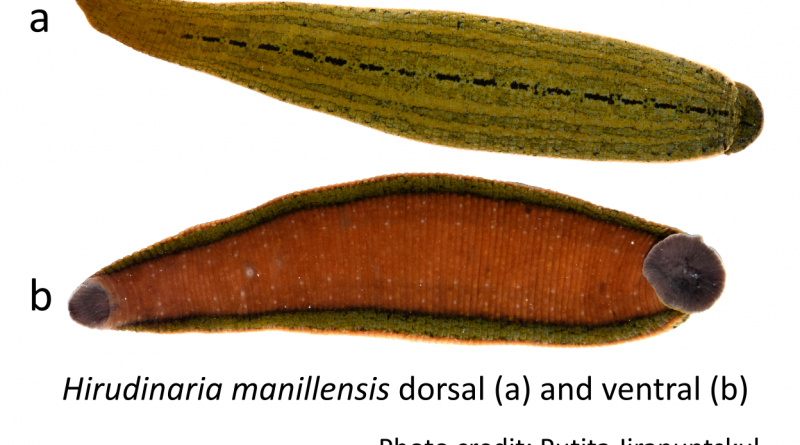Development and Characterization of 18 Microsatellite Markers for the Asian Buffalo Leech Hirudinaria manillensis (Lesson, 1842) and Cross-Species Amplification with Its Congeners
The Asian buffalo leech Hirudinaria manillensis is an obligatory ectoparasite freshwater leech, feeding on blood of vertebrates. Its natural populations have been threatened by habitat destruction and overexploitation for traditional medicine. In this study, we developed 18 species-specific microsatellite markers for H. manillensis using a next-generation sequencing approach. Microsatellite polymorphisms were screened in 30 individuals collected from four localities in Thailand. Number of alleles per locus was relatively high, ranging from 5 to 18, with an average of 9.94. The observed heterozygosity values ranged from 0.200 to 0.900. Ten out of the 18 loci showed significant deviation from Hardy-Weinberg Equilibrium. This might be caused by the Wahlund effect and small sample size. These markers were also successfully cross-species amplified in all of its congeners (H. javanica, H. bpling and H. thailandica), with the amplification success rate between 56–89% of the loci used. These highly polymorphic loci will be useful for further population genetics study of H. manillensis and its congeners.
การพัฒนาและประเมินคุณลักษณะของเครื่องหมายดีเอ็นเอแบบไมโครแซทเทลไลท์สำหรับปลิงควายและการทดสอบในปลิงจีนัสเดียวกัน
ปลิงควาย (Hirudinaria manillensis) เป็นปรสิตน้ำจืด ดำรงชีวิตด้วยการดูดเลือดของสัตว์อื่นกินเป็นอาหาร ประชากรในธรรมชาติถูกคุกคามจากการทำลายแหล่งที่อยู่อาศัยและถูกเก็บไปขายเพื่อใช้เป็นตัวยาแผนโบราณ งานวิจัยนี้ได้พัฒนาเครื่องหมายดีเอ็นเอแบบไมโครแซทเทลไลท์จำนวน 18 ตำแหน่ง และทดสอบความหลากหลายในปลิงควายจำนวน 30 ตัว จาก 4 พื้นที่ในประเทศไทย ไมโครแซทเทลไลท์มีความหลากหลายของอัลลีลสูง อยู่ระหว่าง 5–18 อัลลีล/ตำแหน่ง มีค่าเฉลี่ยเท่ากับ 9.94 ค่าเฮเทอโรไซโกซิตี้ของประชากรตัวอย่างอยู่ระหว่าง 0.200–0.900 ไมโครแซทเทลไลท์ 10 ตำแหน่งไม่อยู่ในสมดุลของฮาร์ดี-ไวน์เบิร์ก อาจเป็นผลมาจากการวิเคราะห์ตัวอย่างจากหลายประชากรรวมกันและประชากรตัวอย่างมีขนาดเล็ก เมื่อนำไมโครแซทเทลไลท์ทั้ง 18 ตำแหน่งไปใช้ในปลิงชนิดอื่นที่อยู่ในจีนัสเดียวกันอีก 3 ชนิด ได้แก่ H. javanica H. bpling และ H. thailandica สามารถเพิ่มปริมาณดีเอ็นเอได้ 56-89% ของตำแหน่งที่ใช้ ไมโครแซทเทลไลท์ที่พัฒนาขึ้นมานี้ มีความเหมาะสมในการนำไปใช้ศึกษาพันธุศาสตร์ประชากรของปลิงควายและปลิงชนิดอื่นในจีนัสเดียวกันได้ต่อไป
ความสอดคล้องหรือสนับสนุน SDGs หลัก 15. ปกป้อง ฟื้นฟู และสนับสนุนการใช้ระบบนิเวศบนบกอย่างยั่งยืน จัดการป่าไม้อย่างยั่งยืน ต่อสู้การกลายสภาพเป็นทะเลทราย หยุดการเสื่อมโทรมของที่ดินและฟื้นสภาพกลับมาใหม่ และหยุดการสูญเสียความหลากหลายทางชีวภาพ
เป้าประสงค์ย่อยใน SDGs หลัก 15.1 สร้างหลักประกันว่าจะมีการอนุรักษ์ การฟื้นฟู และการใช้ระบบนิเวศบนบกและในน้ำจืดในแผ่นดินรวมทั้งบริการทางระบบนิเวศอย่างยั่งยืน เฉพาะอย่างยิ่ง ป่าไม้ พื้นที่ชุ่มน้ำ ภูเขาและเขตแห้งแล้ง โดยเป็นไปตามข้อบังคับภายใต้ความตกลงระหว่างประเทศ ภายในปี 2563
Citation
Jiranuntskul, P., Jeratthitikul, E., Panha, S., & Kongrit, C. (2023). Development and Characterization of 18 Microsatellite Markers for the Asian Buffalo Leech Hirudinaria manillensis (Lesson, 1842) and Cross-Species Amplification with Its Congeners. Tropical Natural History, 23(1), 56–60. Retrieved from https://li01.tci-thaijo.org/index.php/tnh/article/view/259502

